Employee Engagement and Performance: A Case Study of Sierra Mineral
VerifiedAdded on 2023/03/23
|24
|5862
|21
Case Study
AI Summary
This case study investigates the impact of employee engagement on organizational performance at Sierra Mineral Holdings 1 Limited. It begins by outlining the problem statement, research aim, objectives, questions, and hypotheses. The literature review explores the concepts of employee engagement and organizational performance, examining factors such as job satisfaction, employee recognition, relationships with co-workers, organizational culture, and motivation. It also discusses challenges in ensuring active employee engagement and the relationship between engagement and organizational performance. The research methodology section details the research philosophy, approach, design, strategy, sampling technique, data collection process, data analysis technique, ethical considerations, and accessibility issues. The study aims to provide recommendations for improving employee engagement within Sierra Mineral Holdings 1 Limited to enhance overall organizational performance. The conceptual framework highlights the interconnectedness of job satisfaction, employee recognition, relationship with co-workers, and organizational culture in driving employee engagement and, consequently, organizational performance.
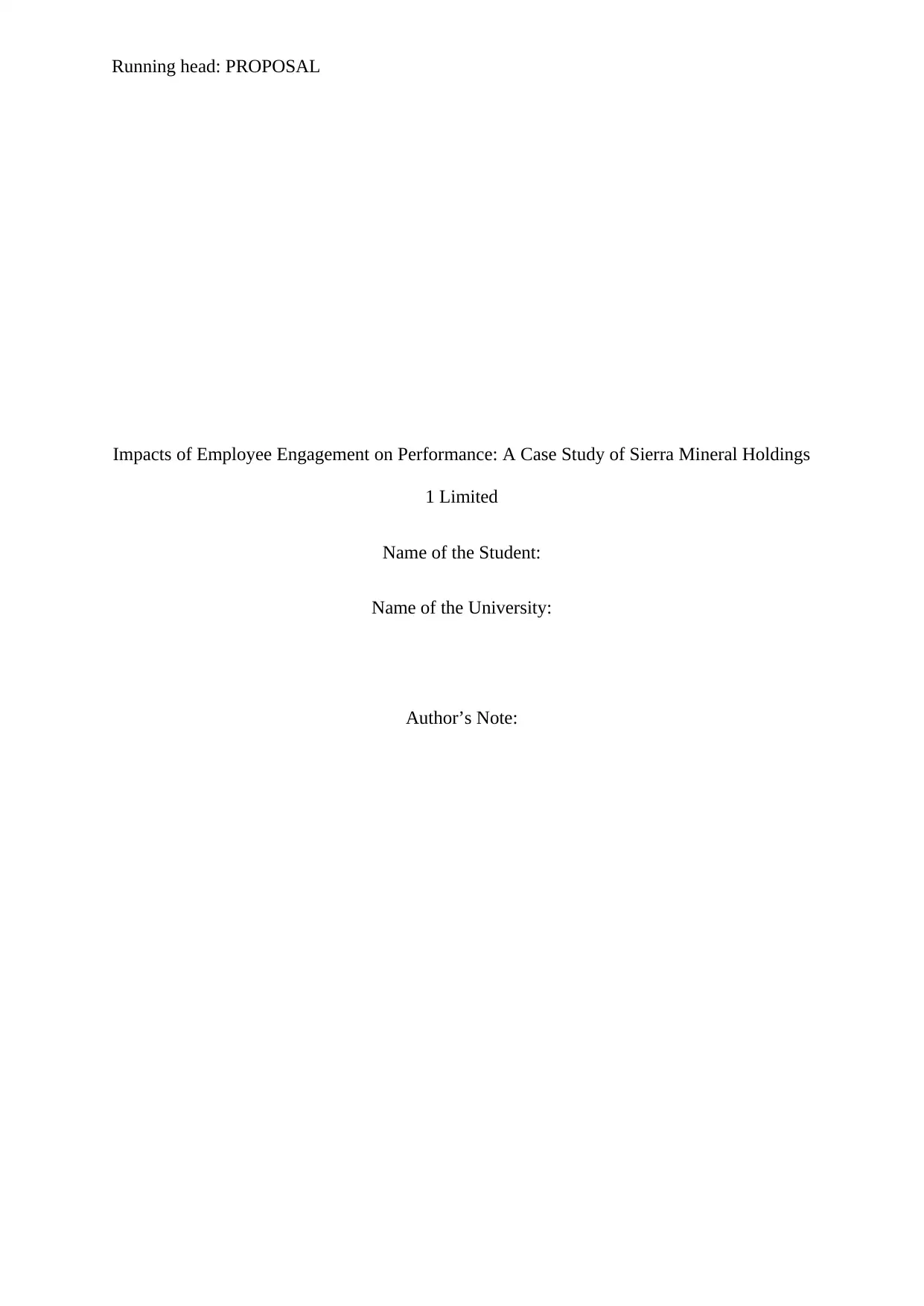
Running head: PROPOSAL
Impacts of Employee Engagement on Performance: A Case Study of Sierra Mineral Holdings
1 Limited
Name of the Student:
Name of the University:
Author’s Note:
Impacts of Employee Engagement on Performance: A Case Study of Sierra Mineral Holdings
1 Limited
Name of the Student:
Name of the University:
Author’s Note:
Paraphrase This Document
Need a fresh take? Get an instant paraphrase of this document with our AI Paraphraser
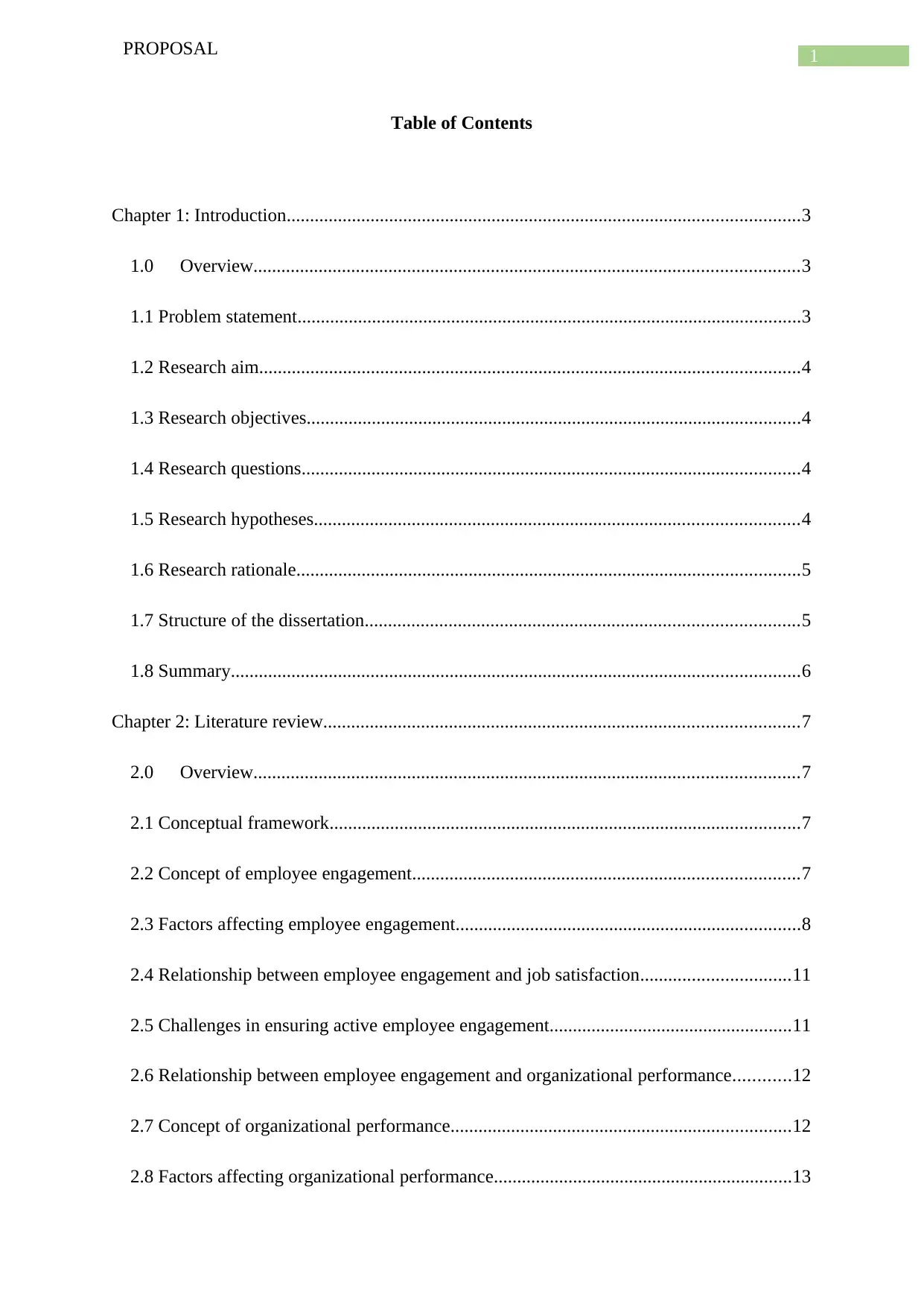
1PROPOSAL
Table of Contents
Chapter 1: Introduction..............................................................................................................3
1.0 Overview.....................................................................................................................3
1.1 Problem statement............................................................................................................3
1.2 Research aim....................................................................................................................4
1.3 Research objectives..........................................................................................................4
1.4 Research questions...........................................................................................................4
1.5 Research hypotheses........................................................................................................4
1.6 Research rationale............................................................................................................5
1.7 Structure of the dissertation.............................................................................................5
1.8 Summary..........................................................................................................................6
Chapter 2: Literature review......................................................................................................7
2.0 Overview.....................................................................................................................7
2.1 Conceptual framework.....................................................................................................7
2.2 Concept of employee engagement...................................................................................7
2.3 Factors affecting employee engagement..........................................................................8
2.4 Relationship between employee engagement and job satisfaction................................11
2.5 Challenges in ensuring active employee engagement....................................................11
2.6 Relationship between employee engagement and organizational performance............12
2.7 Concept of organizational performance.........................................................................12
2.8 Factors affecting organizational performance................................................................13
Table of Contents
Chapter 1: Introduction..............................................................................................................3
1.0 Overview.....................................................................................................................3
1.1 Problem statement............................................................................................................3
1.2 Research aim....................................................................................................................4
1.3 Research objectives..........................................................................................................4
1.4 Research questions...........................................................................................................4
1.5 Research hypotheses........................................................................................................4
1.6 Research rationale............................................................................................................5
1.7 Structure of the dissertation.............................................................................................5
1.8 Summary..........................................................................................................................6
Chapter 2: Literature review......................................................................................................7
2.0 Overview.....................................................................................................................7
2.1 Conceptual framework.....................................................................................................7
2.2 Concept of employee engagement...................................................................................7
2.3 Factors affecting employee engagement..........................................................................8
2.4 Relationship between employee engagement and job satisfaction................................11
2.5 Challenges in ensuring active employee engagement....................................................11
2.6 Relationship between employee engagement and organizational performance............12
2.7 Concept of organizational performance.........................................................................12
2.8 Factors affecting organizational performance................................................................13
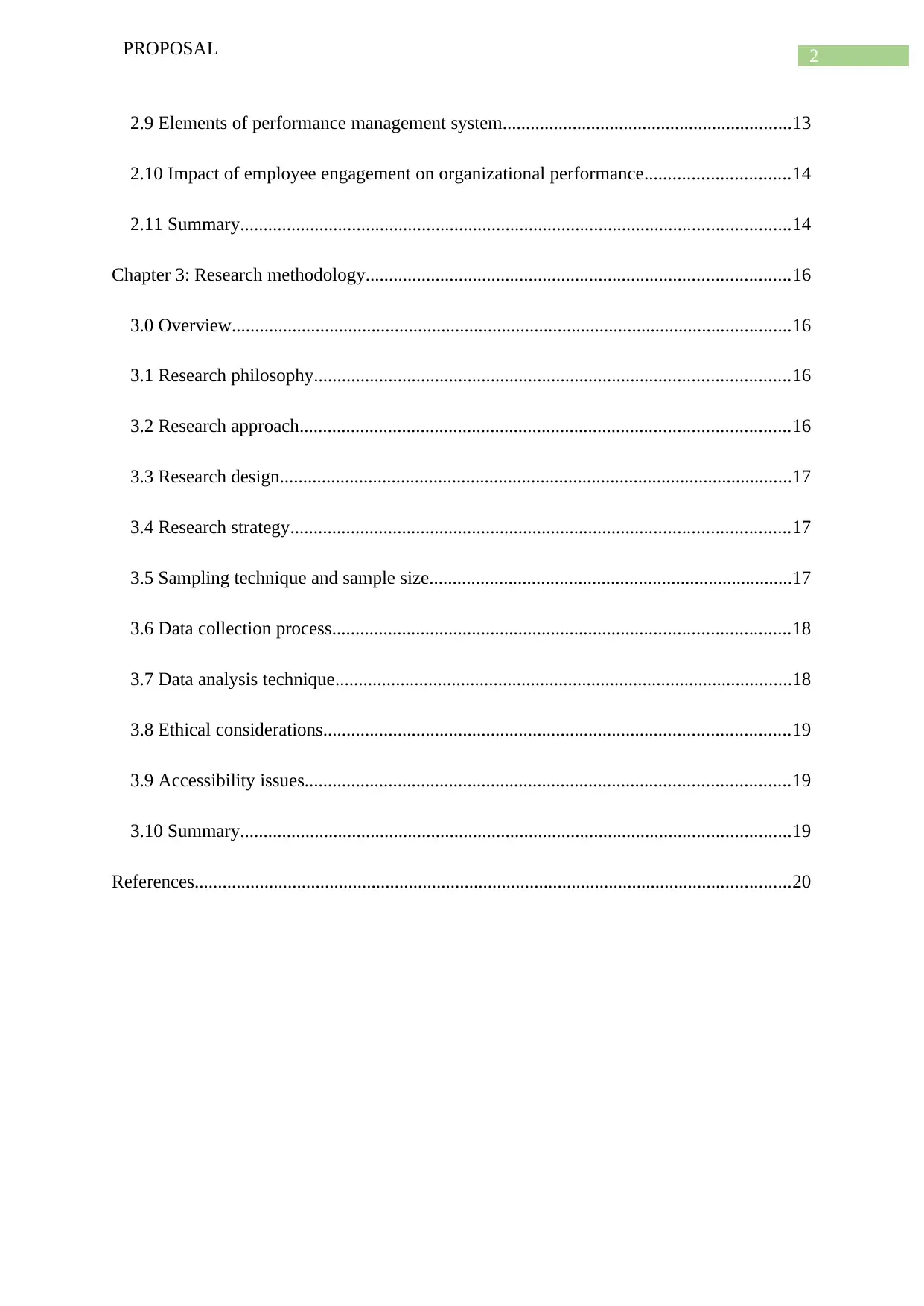
2PROPOSAL
2.9 Elements of performance management system..............................................................13
2.10 Impact of employee engagement on organizational performance...............................14
2.11 Summary......................................................................................................................14
Chapter 3: Research methodology...........................................................................................16
3.0 Overview........................................................................................................................16
3.1 Research philosophy......................................................................................................16
3.2 Research approach.........................................................................................................16
3.3 Research design..............................................................................................................17
3.4 Research strategy...........................................................................................................17
3.5 Sampling technique and sample size..............................................................................17
3.6 Data collection process..................................................................................................18
3.7 Data analysis technique..................................................................................................18
3.8 Ethical considerations....................................................................................................19
3.9 Accessibility issues........................................................................................................19
3.10 Summary......................................................................................................................19
References................................................................................................................................20
2.9 Elements of performance management system..............................................................13
2.10 Impact of employee engagement on organizational performance...............................14
2.11 Summary......................................................................................................................14
Chapter 3: Research methodology...........................................................................................16
3.0 Overview........................................................................................................................16
3.1 Research philosophy......................................................................................................16
3.2 Research approach.........................................................................................................16
3.3 Research design..............................................................................................................17
3.4 Research strategy...........................................................................................................17
3.5 Sampling technique and sample size..............................................................................17
3.6 Data collection process..................................................................................................18
3.7 Data analysis technique..................................................................................................18
3.8 Ethical considerations....................................................................................................19
3.9 Accessibility issues........................................................................................................19
3.10 Summary......................................................................................................................19
References................................................................................................................................20
⊘ This is a preview!⊘
Do you want full access?
Subscribe today to unlock all pages.

Trusted by 1+ million students worldwide
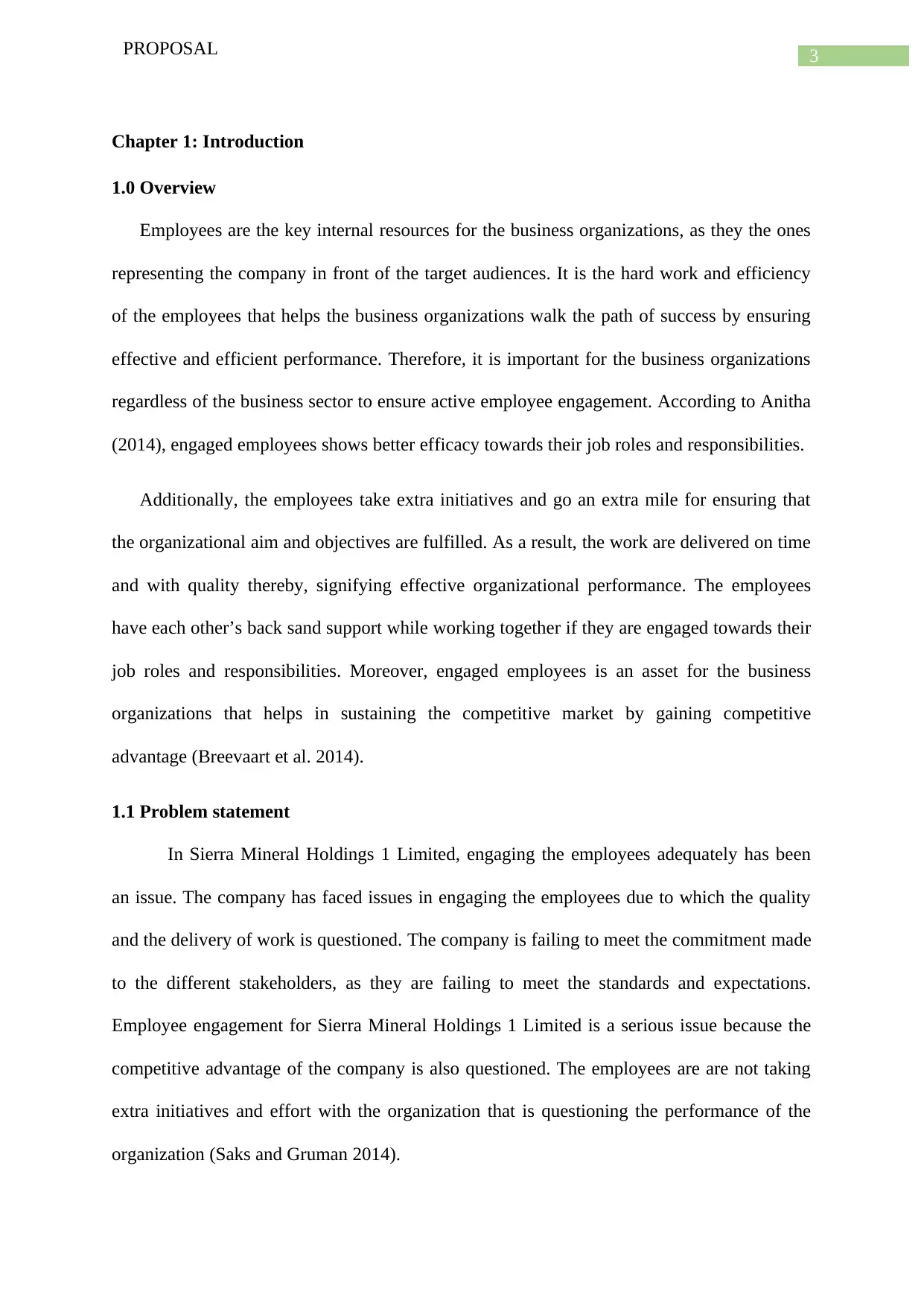
3PROPOSAL
Chapter 1: Introduction
1.0 Overview
Employees are the key internal resources for the business organizations, as they the ones
representing the company in front of the target audiences. It is the hard work and efficiency
of the employees that helps the business organizations walk the path of success by ensuring
effective and efficient performance. Therefore, it is important for the business organizations
regardless of the business sector to ensure active employee engagement. According to Anitha
(2014), engaged employees shows better efficacy towards their job roles and responsibilities.
Additionally, the employees take extra initiatives and go an extra mile for ensuring that
the organizational aim and objectives are fulfilled. As a result, the work are delivered on time
and with quality thereby, signifying effective organizational performance. The employees
have each other’s back sand support while working together if they are engaged towards their
job roles and responsibilities. Moreover, engaged employees is an asset for the business
organizations that helps in sustaining the competitive market by gaining competitive
advantage (Breevaart et al. 2014).
1.1 Problem statement
In Sierra Mineral Holdings 1 Limited, engaging the employees adequately has been
an issue. The company has faced issues in engaging the employees due to which the quality
and the delivery of work is questioned. The company is failing to meet the commitment made
to the different stakeholders, as they are failing to meet the standards and expectations.
Employee engagement for Sierra Mineral Holdings 1 Limited is a serious issue because the
competitive advantage of the company is also questioned. The employees are are not taking
extra initiatives and effort with the organization that is questioning the performance of the
organization (Saks and Gruman 2014).
Chapter 1: Introduction
1.0 Overview
Employees are the key internal resources for the business organizations, as they the ones
representing the company in front of the target audiences. It is the hard work and efficiency
of the employees that helps the business organizations walk the path of success by ensuring
effective and efficient performance. Therefore, it is important for the business organizations
regardless of the business sector to ensure active employee engagement. According to Anitha
(2014), engaged employees shows better efficacy towards their job roles and responsibilities.
Additionally, the employees take extra initiatives and go an extra mile for ensuring that
the organizational aim and objectives are fulfilled. As a result, the work are delivered on time
and with quality thereby, signifying effective organizational performance. The employees
have each other’s back sand support while working together if they are engaged towards their
job roles and responsibilities. Moreover, engaged employees is an asset for the business
organizations that helps in sustaining the competitive market by gaining competitive
advantage (Breevaart et al. 2014).
1.1 Problem statement
In Sierra Mineral Holdings 1 Limited, engaging the employees adequately has been
an issue. The company has faced issues in engaging the employees due to which the quality
and the delivery of work is questioned. The company is failing to meet the commitment made
to the different stakeholders, as they are failing to meet the standards and expectations.
Employee engagement for Sierra Mineral Holdings 1 Limited is a serious issue because the
competitive advantage of the company is also questioned. The employees are are not taking
extra initiatives and effort with the organization that is questioning the performance of the
organization (Saks and Gruman 2014).
Paraphrase This Document
Need a fresh take? Get an instant paraphrase of this document with our AI Paraphraser
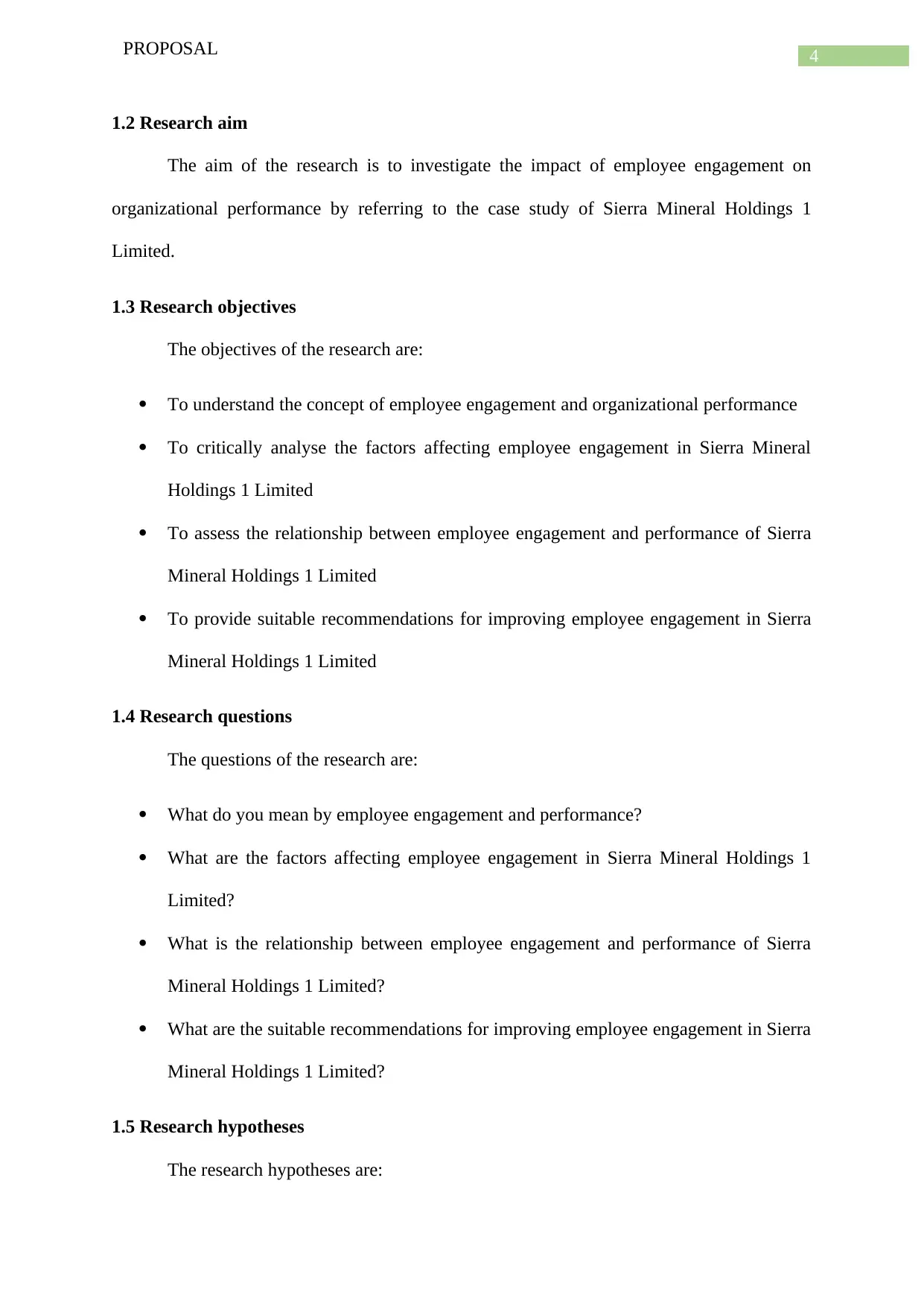
4PROPOSAL
1.2 Research aim
The aim of the research is to investigate the impact of employee engagement on
organizational performance by referring to the case study of Sierra Mineral Holdings 1
Limited.
1.3 Research objectives
The objectives of the research are:
To understand the concept of employee engagement and organizational performance
To critically analyse the factors affecting employee engagement in Sierra Mineral
Holdings 1 Limited
To assess the relationship between employee engagement and performance of Sierra
Mineral Holdings 1 Limited
To provide suitable recommendations for improving employee engagement in Sierra
Mineral Holdings 1 Limited
1.4 Research questions
The questions of the research are:
What do you mean by employee engagement and performance?
What are the factors affecting employee engagement in Sierra Mineral Holdings 1
Limited?
What is the relationship between employee engagement and performance of Sierra
Mineral Holdings 1 Limited?
What are the suitable recommendations for improving employee engagement in Sierra
Mineral Holdings 1 Limited?
1.5 Research hypotheses
The research hypotheses are:
1.2 Research aim
The aim of the research is to investigate the impact of employee engagement on
organizational performance by referring to the case study of Sierra Mineral Holdings 1
Limited.
1.3 Research objectives
The objectives of the research are:
To understand the concept of employee engagement and organizational performance
To critically analyse the factors affecting employee engagement in Sierra Mineral
Holdings 1 Limited
To assess the relationship between employee engagement and performance of Sierra
Mineral Holdings 1 Limited
To provide suitable recommendations for improving employee engagement in Sierra
Mineral Holdings 1 Limited
1.4 Research questions
The questions of the research are:
What do you mean by employee engagement and performance?
What are the factors affecting employee engagement in Sierra Mineral Holdings 1
Limited?
What is the relationship between employee engagement and performance of Sierra
Mineral Holdings 1 Limited?
What are the suitable recommendations for improving employee engagement in Sierra
Mineral Holdings 1 Limited?
1.5 Research hypotheses
The research hypotheses are:
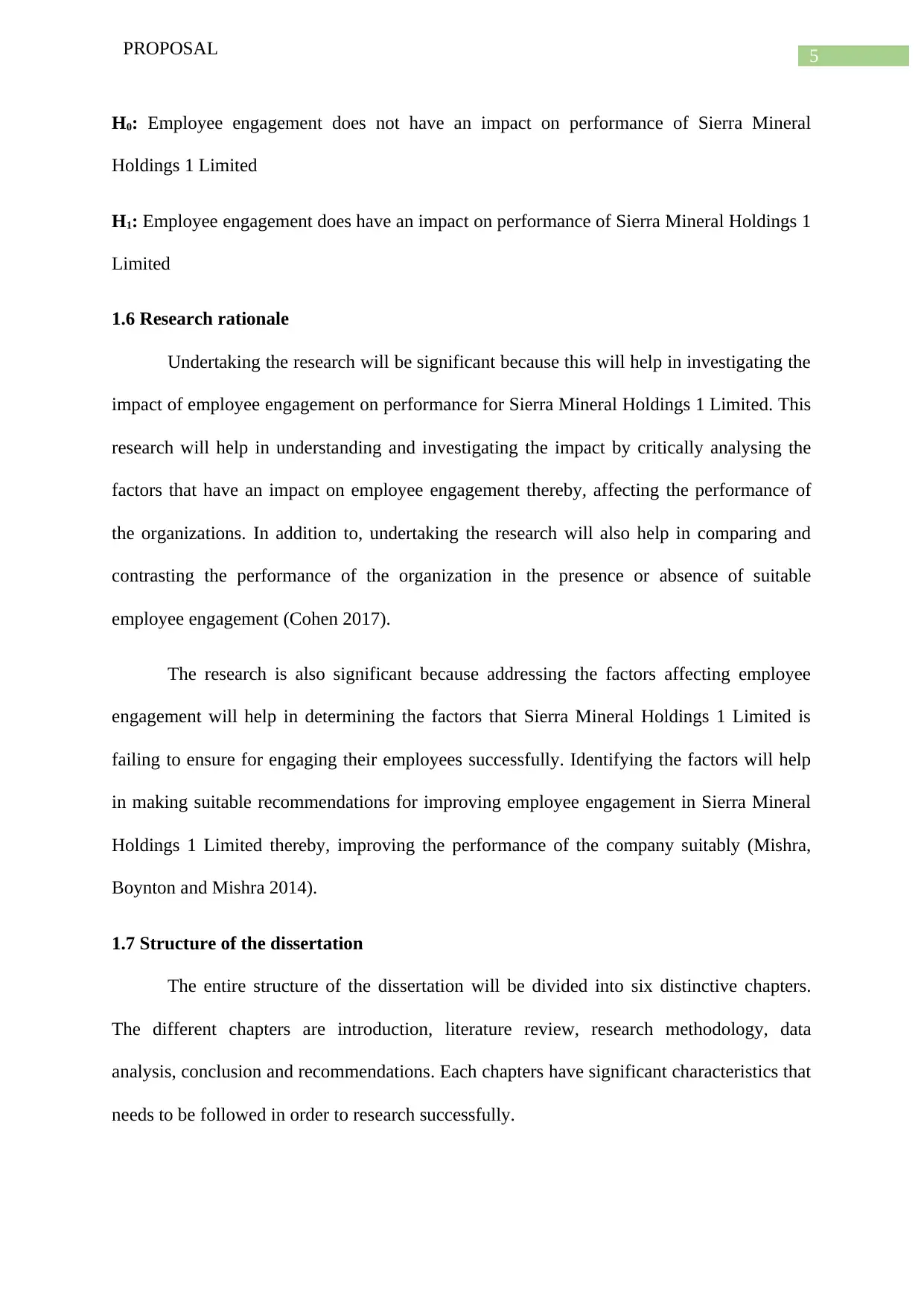
5PROPOSAL
H0: Employee engagement does not have an impact on performance of Sierra Mineral
Holdings 1 Limited
H1: Employee engagement does have an impact on performance of Sierra Mineral Holdings 1
Limited
1.6 Research rationale
Undertaking the research will be significant because this will help in investigating the
impact of employee engagement on performance for Sierra Mineral Holdings 1 Limited. This
research will help in understanding and investigating the impact by critically analysing the
factors that have an impact on employee engagement thereby, affecting the performance of
the organizations. In addition to, undertaking the research will also help in comparing and
contrasting the performance of the organization in the presence or absence of suitable
employee engagement (Cohen 2017).
The research is also significant because addressing the factors affecting employee
engagement will help in determining the factors that Sierra Mineral Holdings 1 Limited is
failing to ensure for engaging their employees successfully. Identifying the factors will help
in making suitable recommendations for improving employee engagement in Sierra Mineral
Holdings 1 Limited thereby, improving the performance of the company suitably (Mishra,
Boynton and Mishra 2014).
1.7 Structure of the dissertation
The entire structure of the dissertation will be divided into six distinctive chapters.
The different chapters are introduction, literature review, research methodology, data
analysis, conclusion and recommendations. Each chapters have significant characteristics that
needs to be followed in order to research successfully.
H0: Employee engagement does not have an impact on performance of Sierra Mineral
Holdings 1 Limited
H1: Employee engagement does have an impact on performance of Sierra Mineral Holdings 1
Limited
1.6 Research rationale
Undertaking the research will be significant because this will help in investigating the
impact of employee engagement on performance for Sierra Mineral Holdings 1 Limited. This
research will help in understanding and investigating the impact by critically analysing the
factors that have an impact on employee engagement thereby, affecting the performance of
the organizations. In addition to, undertaking the research will also help in comparing and
contrasting the performance of the organization in the presence or absence of suitable
employee engagement (Cohen 2017).
The research is also significant because addressing the factors affecting employee
engagement will help in determining the factors that Sierra Mineral Holdings 1 Limited is
failing to ensure for engaging their employees successfully. Identifying the factors will help
in making suitable recommendations for improving employee engagement in Sierra Mineral
Holdings 1 Limited thereby, improving the performance of the company suitably (Mishra,
Boynton and Mishra 2014).
1.7 Structure of the dissertation
The entire structure of the dissertation will be divided into six distinctive chapters.
The different chapters are introduction, literature review, research methodology, data
analysis, conclusion and recommendations. Each chapters have significant characteristics that
needs to be followed in order to research successfully.
⊘ This is a preview!⊘
Do you want full access?
Subscribe today to unlock all pages.

Trusted by 1+ million students worldwide
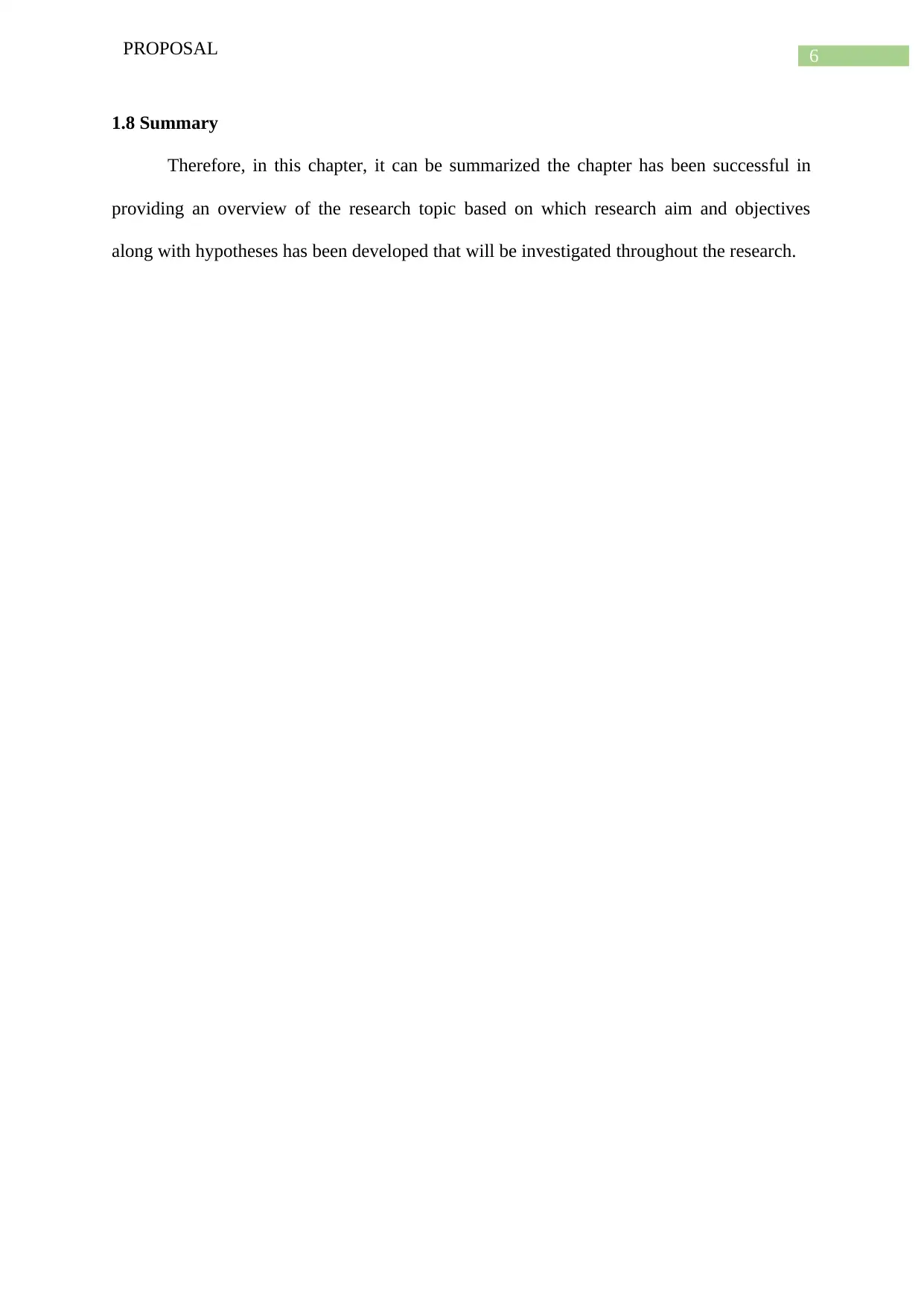
6PROPOSAL
1.8 Summary
Therefore, in this chapter, it can be summarized the chapter has been successful in
providing an overview of the research topic based on which research aim and objectives
along with hypotheses has been developed that will be investigated throughout the research.
1.8 Summary
Therefore, in this chapter, it can be summarized the chapter has been successful in
providing an overview of the research topic based on which research aim and objectives
along with hypotheses has been developed that will be investigated throughout the research.
Paraphrase This Document
Need a fresh take? Get an instant paraphrase of this document with our AI Paraphraser
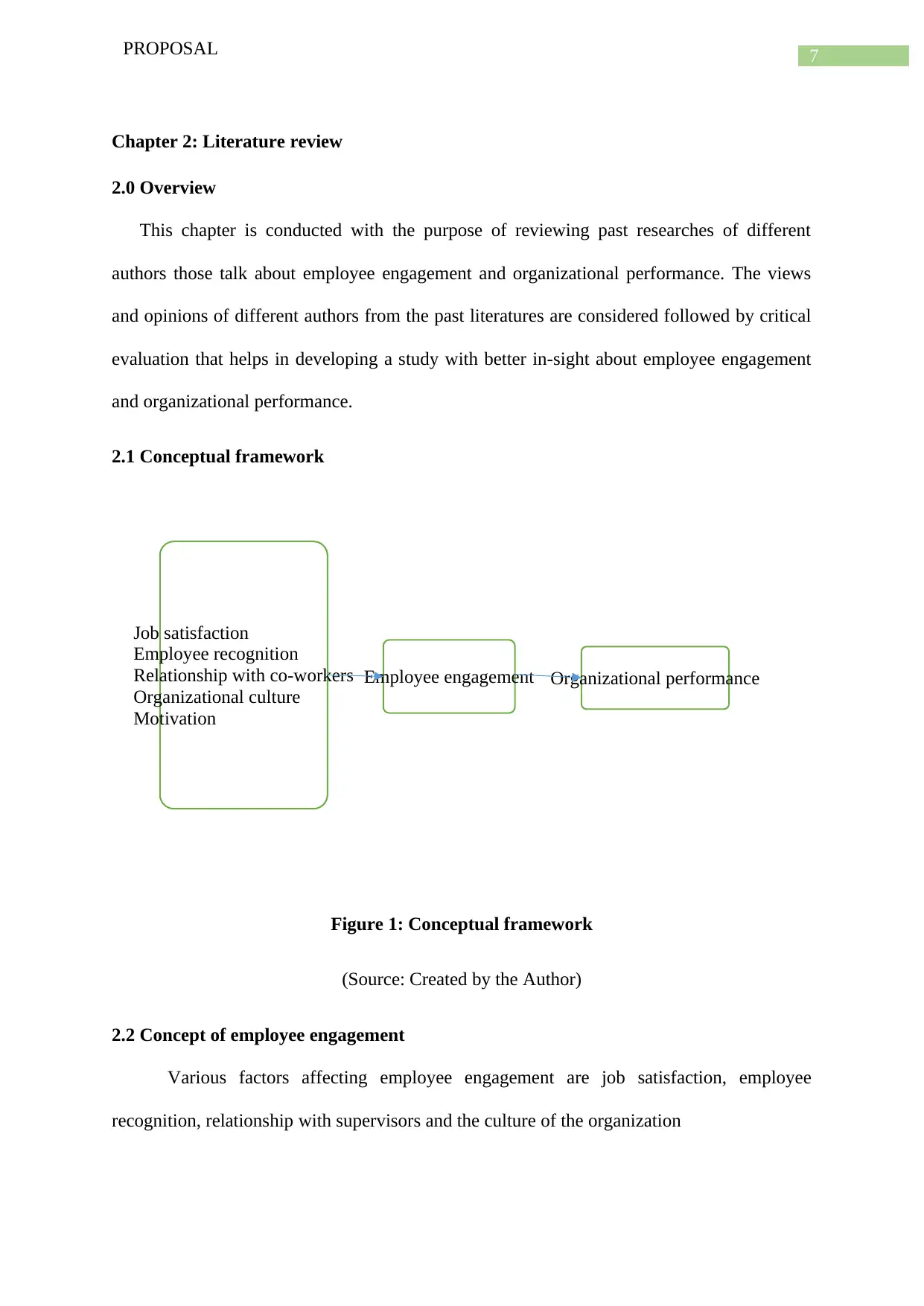
7PROPOSAL
Employee engagement
Job satisfaction
Employee recognition
Relationship with co-workers
Organizational culture
Motivation
Organizational performance
Chapter 2: Literature review
2.0 Overview
This chapter is conducted with the purpose of reviewing past researches of different
authors those talk about employee engagement and organizational performance. The views
and opinions of different authors from the past literatures are considered followed by critical
evaluation that helps in developing a study with better in-sight about employee engagement
and organizational performance.
2.1 Conceptual framework
Figure 1: Conceptual framework
(Source: Created by the Author)
2.2 Concept of employee engagement
Various factors affecting employee engagement are job satisfaction, employee
recognition, relationship with supervisors and the culture of the organization
Employee engagement
Job satisfaction
Employee recognition
Relationship with co-workers
Organizational culture
Motivation
Organizational performance
Chapter 2: Literature review
2.0 Overview
This chapter is conducted with the purpose of reviewing past researches of different
authors those talk about employee engagement and organizational performance. The views
and opinions of different authors from the past literatures are considered followed by critical
evaluation that helps in developing a study with better in-sight about employee engagement
and organizational performance.
2.1 Conceptual framework
Figure 1: Conceptual framework
(Source: Created by the Author)
2.2 Concept of employee engagement
Various factors affecting employee engagement are job satisfaction, employee
recognition, relationship with supervisors and the culture of the organization
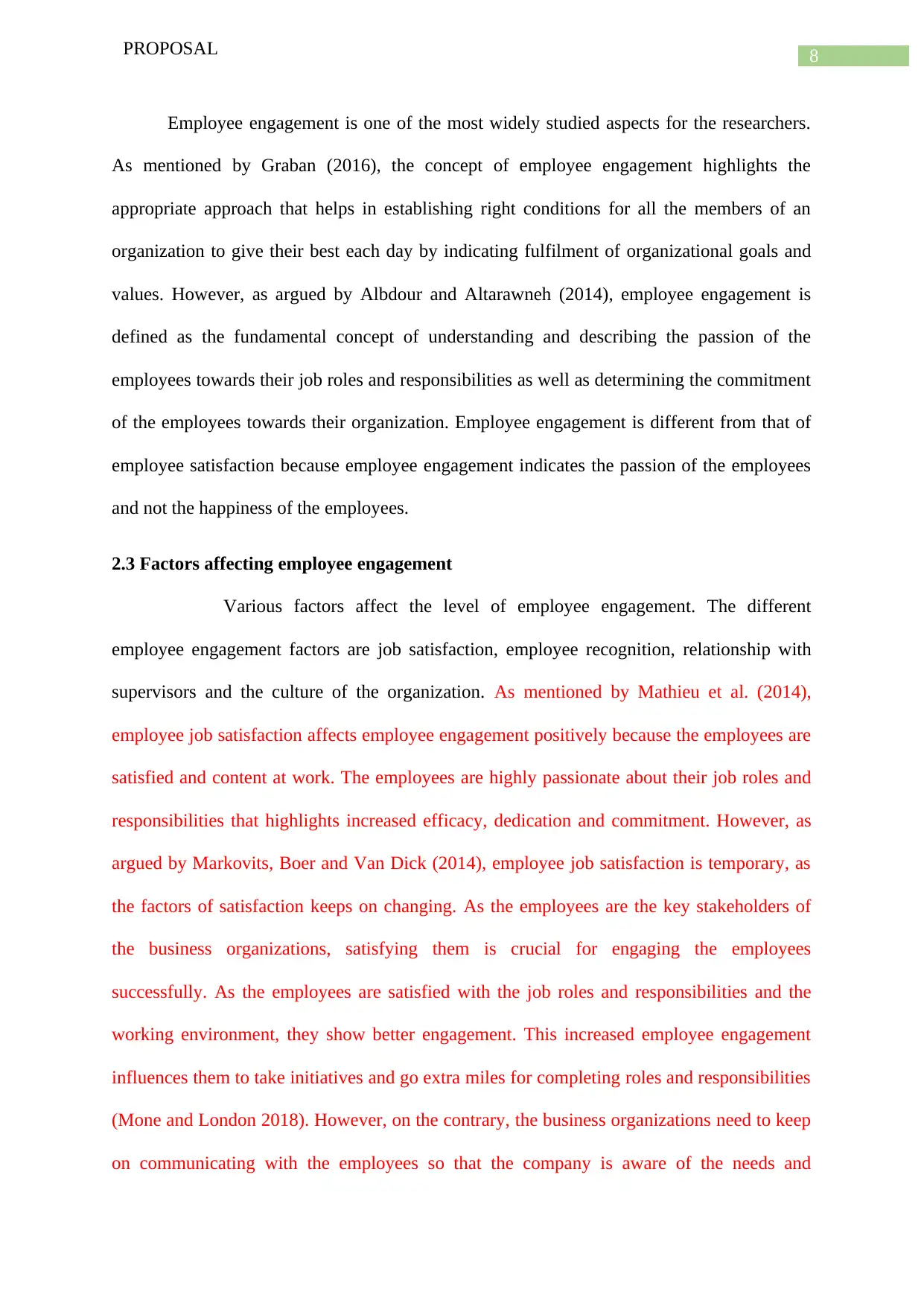
8PROPOSAL
Employee engagement is one of the most widely studied aspects for the researchers.
As mentioned by Graban (2016), the concept of employee engagement highlights the
appropriate approach that helps in establishing right conditions for all the members of an
organization to give their best each day by indicating fulfilment of organizational goals and
values. However, as argued by Albdour and Altarawneh (2014), employee engagement is
defined as the fundamental concept of understanding and describing the passion of the
employees towards their job roles and responsibilities as well as determining the commitment
of the employees towards their organization. Employee engagement is different from that of
employee satisfaction because employee engagement indicates the passion of the employees
and not the happiness of the employees.
2.3 Factors affecting employee engagement
Various factors affect the level of employee engagement. The different
employee engagement factors are job satisfaction, employee recognition, relationship with
supervisors and the culture of the organization. As mentioned by Mathieu et al. (2014),
employee job satisfaction affects employee engagement positively because the employees are
satisfied and content at work. The employees are highly passionate about their job roles and
responsibilities that highlights increased efficacy, dedication and commitment. However, as
argued by Markovits, Boer and Van Dick (2014), employee job satisfaction is temporary, as
the factors of satisfaction keeps on changing. As the employees are the key stakeholders of
the business organizations, satisfying them is crucial for engaging the employees
successfully. As the employees are satisfied with the job roles and responsibilities and the
working environment, they show better engagement. This increased employee engagement
influences them to take initiatives and go extra miles for completing roles and responsibilities
(Mone and London 2018). However, on the contrary, the business organizations need to keep
on communicating with the employees so that the company is aware of the needs and
Employee engagement is one of the most widely studied aspects for the researchers.
As mentioned by Graban (2016), the concept of employee engagement highlights the
appropriate approach that helps in establishing right conditions for all the members of an
organization to give their best each day by indicating fulfilment of organizational goals and
values. However, as argued by Albdour and Altarawneh (2014), employee engagement is
defined as the fundamental concept of understanding and describing the passion of the
employees towards their job roles and responsibilities as well as determining the commitment
of the employees towards their organization. Employee engagement is different from that of
employee satisfaction because employee engagement indicates the passion of the employees
and not the happiness of the employees.
2.3 Factors affecting employee engagement
Various factors affect the level of employee engagement. The different
employee engagement factors are job satisfaction, employee recognition, relationship with
supervisors and the culture of the organization. As mentioned by Mathieu et al. (2014),
employee job satisfaction affects employee engagement positively because the employees are
satisfied and content at work. The employees are highly passionate about their job roles and
responsibilities that highlights increased efficacy, dedication and commitment. However, as
argued by Markovits, Boer and Van Dick (2014), employee job satisfaction is temporary, as
the factors of satisfaction keeps on changing. As the employees are the key stakeholders of
the business organizations, satisfying them is crucial for engaging the employees
successfully. As the employees are satisfied with the job roles and responsibilities and the
working environment, they show better engagement. This increased employee engagement
influences them to take initiatives and go extra miles for completing roles and responsibilities
(Mone and London 2018). However, on the contrary, the business organizations need to keep
on communicating with the employees so that the company is aware of the needs and
⊘ This is a preview!⊘
Do you want full access?
Subscribe today to unlock all pages.

Trusted by 1+ million students worldwide
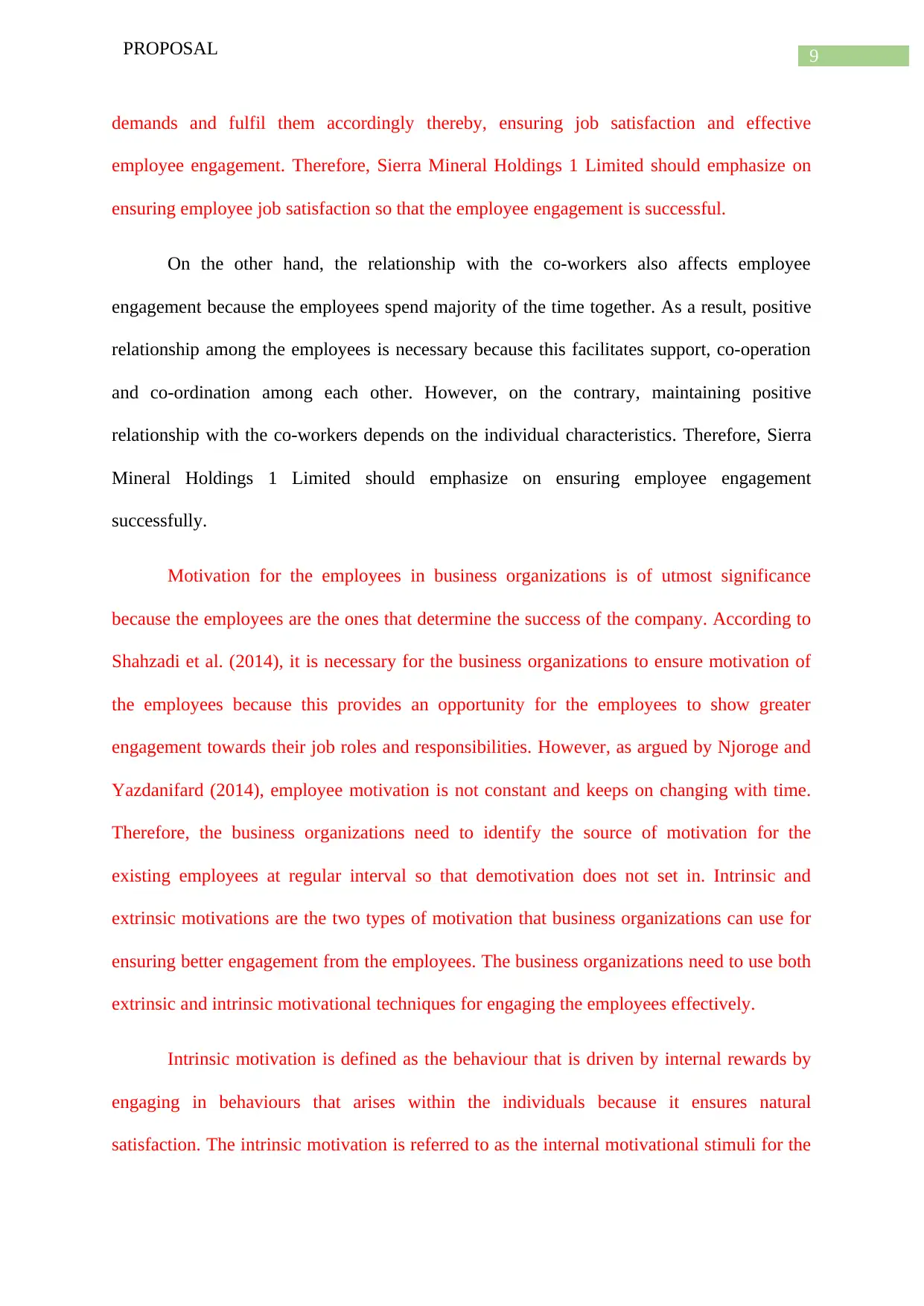
9PROPOSAL
demands and fulfil them accordingly thereby, ensuring job satisfaction and effective
employee engagement. Therefore, Sierra Mineral Holdings 1 Limited should emphasize on
ensuring employee job satisfaction so that the employee engagement is successful.
On the other hand, the relationship with the co-workers also affects employee
engagement because the employees spend majority of the time together. As a result, positive
relationship among the employees is necessary because this facilitates support, co-operation
and co-ordination among each other. However, on the contrary, maintaining positive
relationship with the co-workers depends on the individual characteristics. Therefore, Sierra
Mineral Holdings 1 Limited should emphasize on ensuring employee engagement
successfully.
Motivation for the employees in business organizations is of utmost significance
because the employees are the ones that determine the success of the company. According to
Shahzadi et al. (2014), it is necessary for the business organizations to ensure motivation of
the employees because this provides an opportunity for the employees to show greater
engagement towards their job roles and responsibilities. However, as argued by Njoroge and
Yazdanifard (2014), employee motivation is not constant and keeps on changing with time.
Therefore, the business organizations need to identify the source of motivation for the
existing employees at regular interval so that demotivation does not set in. Intrinsic and
extrinsic motivations are the two types of motivation that business organizations can use for
ensuring better engagement from the employees. The business organizations need to use both
extrinsic and intrinsic motivational techniques for engaging the employees effectively.
Intrinsic motivation is defined as the behaviour that is driven by internal rewards by
engaging in behaviours that arises within the individuals because it ensures natural
satisfaction. The intrinsic motivation is referred to as the internal motivational stimuli for the
demands and fulfil them accordingly thereby, ensuring job satisfaction and effective
employee engagement. Therefore, Sierra Mineral Holdings 1 Limited should emphasize on
ensuring employee job satisfaction so that the employee engagement is successful.
On the other hand, the relationship with the co-workers also affects employee
engagement because the employees spend majority of the time together. As a result, positive
relationship among the employees is necessary because this facilitates support, co-operation
and co-ordination among each other. However, on the contrary, maintaining positive
relationship with the co-workers depends on the individual characteristics. Therefore, Sierra
Mineral Holdings 1 Limited should emphasize on ensuring employee engagement
successfully.
Motivation for the employees in business organizations is of utmost significance
because the employees are the ones that determine the success of the company. According to
Shahzadi et al. (2014), it is necessary for the business organizations to ensure motivation of
the employees because this provides an opportunity for the employees to show greater
engagement towards their job roles and responsibilities. However, as argued by Njoroge and
Yazdanifard (2014), employee motivation is not constant and keeps on changing with time.
Therefore, the business organizations need to identify the source of motivation for the
existing employees at regular interval so that demotivation does not set in. Intrinsic and
extrinsic motivations are the two types of motivation that business organizations can use for
ensuring better engagement from the employees. The business organizations need to use both
extrinsic and intrinsic motivational techniques for engaging the employees effectively.
Intrinsic motivation is defined as the behaviour that is driven by internal rewards by
engaging in behaviours that arises within the individuals because it ensures natural
satisfaction. The intrinsic motivation is referred to as the internal motivational stimuli for the
Paraphrase This Document
Need a fresh take? Get an instant paraphrase of this document with our AI Paraphraser
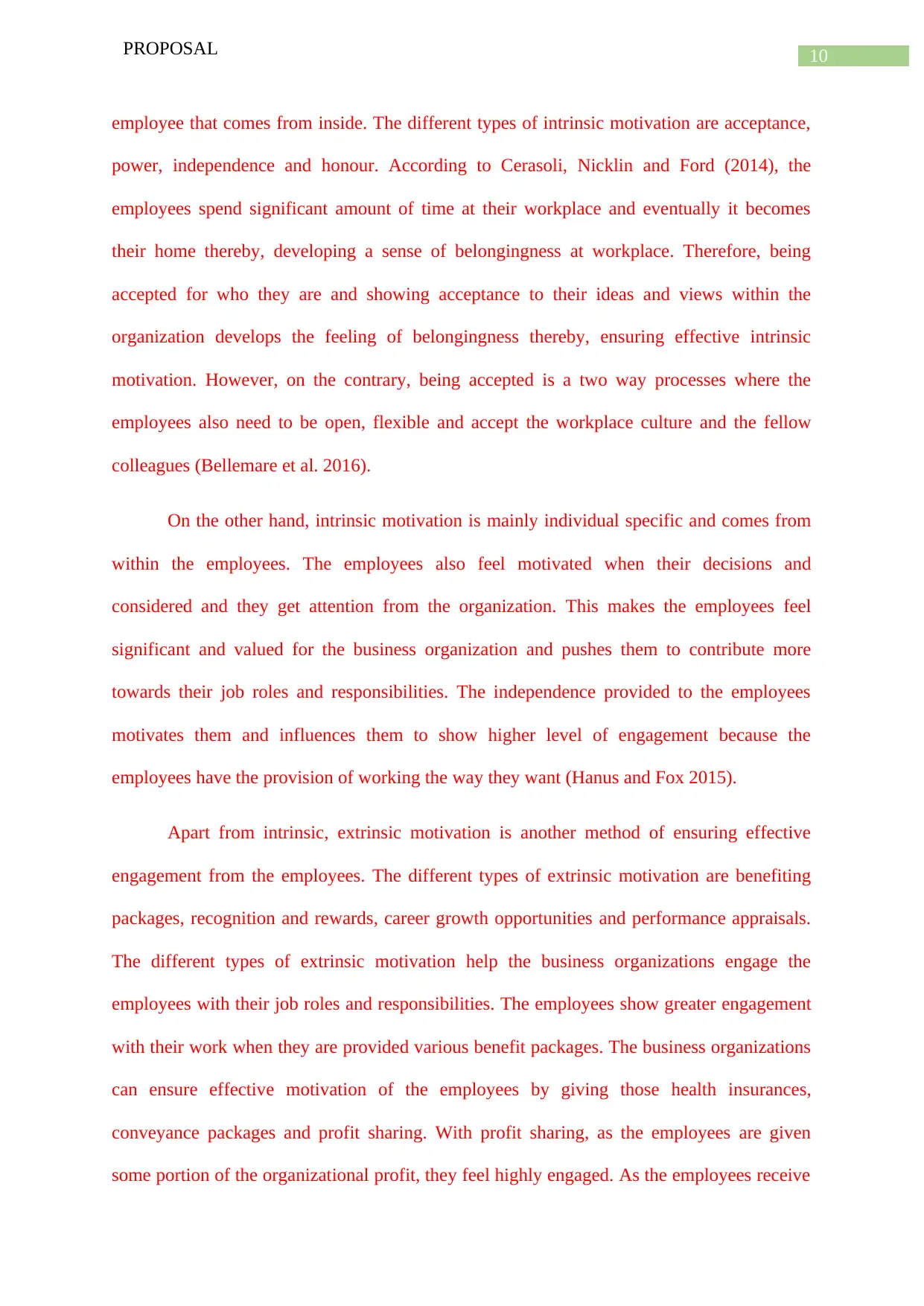
10PROPOSAL
employee that comes from inside. The different types of intrinsic motivation are acceptance,
power, independence and honour. According to Cerasoli, Nicklin and Ford (2014), the
employees spend significant amount of time at their workplace and eventually it becomes
their home thereby, developing a sense of belongingness at workplace. Therefore, being
accepted for who they are and showing acceptance to their ideas and views within the
organization develops the feeling of belongingness thereby, ensuring effective intrinsic
motivation. However, on the contrary, being accepted is a two way processes where the
employees also need to be open, flexible and accept the workplace culture and the fellow
colleagues (Bellemare et al. 2016).
On the other hand, intrinsic motivation is mainly individual specific and comes from
within the employees. The employees also feel motivated when their decisions and
considered and they get attention from the organization. This makes the employees feel
significant and valued for the business organization and pushes them to contribute more
towards their job roles and responsibilities. The independence provided to the employees
motivates them and influences them to show higher level of engagement because the
employees have the provision of working the way they want (Hanus and Fox 2015).
Apart from intrinsic, extrinsic motivation is another method of ensuring effective
engagement from the employees. The different types of extrinsic motivation are benefiting
packages, recognition and rewards, career growth opportunities and performance appraisals.
The different types of extrinsic motivation help the business organizations engage the
employees with their job roles and responsibilities. The employees show greater engagement
with their work when they are provided various benefit packages. The business organizations
can ensure effective motivation of the employees by giving those health insurances,
conveyance packages and profit sharing. With profit sharing, as the employees are given
some portion of the organizational profit, they feel highly engaged. As the employees receive
employee that comes from inside. The different types of intrinsic motivation are acceptance,
power, independence and honour. According to Cerasoli, Nicklin and Ford (2014), the
employees spend significant amount of time at their workplace and eventually it becomes
their home thereby, developing a sense of belongingness at workplace. Therefore, being
accepted for who they are and showing acceptance to their ideas and views within the
organization develops the feeling of belongingness thereby, ensuring effective intrinsic
motivation. However, on the contrary, being accepted is a two way processes where the
employees also need to be open, flexible and accept the workplace culture and the fellow
colleagues (Bellemare et al. 2016).
On the other hand, intrinsic motivation is mainly individual specific and comes from
within the employees. The employees also feel motivated when their decisions and
considered and they get attention from the organization. This makes the employees feel
significant and valued for the business organization and pushes them to contribute more
towards their job roles and responsibilities. The independence provided to the employees
motivates them and influences them to show higher level of engagement because the
employees have the provision of working the way they want (Hanus and Fox 2015).
Apart from intrinsic, extrinsic motivation is another method of ensuring effective
engagement from the employees. The different types of extrinsic motivation are benefiting
packages, recognition and rewards, career growth opportunities and performance appraisals.
The different types of extrinsic motivation help the business organizations engage the
employees with their job roles and responsibilities. The employees show greater engagement
with their work when they are provided various benefit packages. The business organizations
can ensure effective motivation of the employees by giving those health insurances,
conveyance packages and profit sharing. With profit sharing, as the employees are given
some portion of the organizational profit, they feel highly engaged. As the employees receive
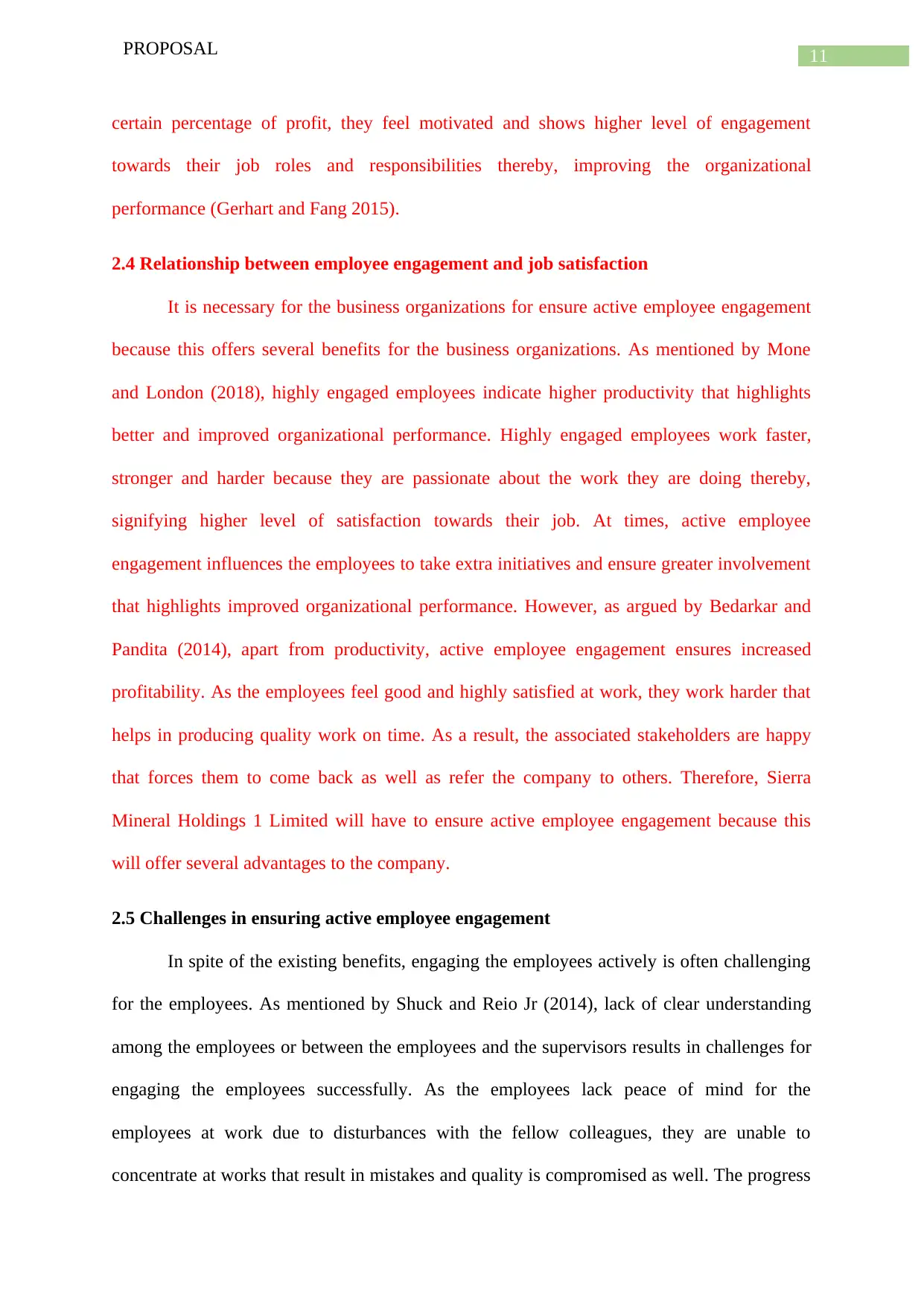
11PROPOSAL
certain percentage of profit, they feel motivated and shows higher level of engagement
towards their job roles and responsibilities thereby, improving the organizational
performance (Gerhart and Fang 2015).
2.4 Relationship between employee engagement and job satisfaction
It is necessary for the business organizations for ensure active employee engagement
because this offers several benefits for the business organizations. As mentioned by Mone
and London (2018), highly engaged employees indicate higher productivity that highlights
better and improved organizational performance. Highly engaged employees work faster,
stronger and harder because they are passionate about the work they are doing thereby,
signifying higher level of satisfaction towards their job. At times, active employee
engagement influences the employees to take extra initiatives and ensure greater involvement
that highlights improved organizational performance. However, as argued by Bedarkar and
Pandita (2014), apart from productivity, active employee engagement ensures increased
profitability. As the employees feel good and highly satisfied at work, they work harder that
helps in producing quality work on time. As a result, the associated stakeholders are happy
that forces them to come back as well as refer the company to others. Therefore, Sierra
Mineral Holdings 1 Limited will have to ensure active employee engagement because this
will offer several advantages to the company.
2.5 Challenges in ensuring active employee engagement
In spite of the existing benefits, engaging the employees actively is often challenging
for the employees. As mentioned by Shuck and Reio Jr (2014), lack of clear understanding
among the employees or between the employees and the supervisors results in challenges for
engaging the employees successfully. As the employees lack peace of mind for the
employees at work due to disturbances with the fellow colleagues, they are unable to
concentrate at works that result in mistakes and quality is compromised as well. The progress
certain percentage of profit, they feel motivated and shows higher level of engagement
towards their job roles and responsibilities thereby, improving the organizational
performance (Gerhart and Fang 2015).
2.4 Relationship between employee engagement and job satisfaction
It is necessary for the business organizations for ensure active employee engagement
because this offers several benefits for the business organizations. As mentioned by Mone
and London (2018), highly engaged employees indicate higher productivity that highlights
better and improved organizational performance. Highly engaged employees work faster,
stronger and harder because they are passionate about the work they are doing thereby,
signifying higher level of satisfaction towards their job. At times, active employee
engagement influences the employees to take extra initiatives and ensure greater involvement
that highlights improved organizational performance. However, as argued by Bedarkar and
Pandita (2014), apart from productivity, active employee engagement ensures increased
profitability. As the employees feel good and highly satisfied at work, they work harder that
helps in producing quality work on time. As a result, the associated stakeholders are happy
that forces them to come back as well as refer the company to others. Therefore, Sierra
Mineral Holdings 1 Limited will have to ensure active employee engagement because this
will offer several advantages to the company.
2.5 Challenges in ensuring active employee engagement
In spite of the existing benefits, engaging the employees actively is often challenging
for the employees. As mentioned by Shuck and Reio Jr (2014), lack of clear understanding
among the employees or between the employees and the supervisors results in challenges for
engaging the employees successfully. As the employees lack peace of mind for the
employees at work due to disturbances with the fellow colleagues, they are unable to
concentrate at works that result in mistakes and quality is compromised as well. The progress
⊘ This is a preview!⊘
Do you want full access?
Subscribe today to unlock all pages.

Trusted by 1+ million students worldwide
1 out of 24
Related Documents
Your All-in-One AI-Powered Toolkit for Academic Success.
+13062052269
info@desklib.com
Available 24*7 on WhatsApp / Email
![[object Object]](/_next/static/media/star-bottom.7253800d.svg)
Unlock your academic potential
Copyright © 2020–2025 A2Z Services. All Rights Reserved. Developed and managed by ZUCOL.





